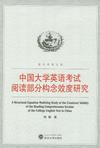中国大学英语考试阅读部分构念效度研究
出版时间:2012-5 出版社:武汉大学出版社 作者:桂敏 页数:199 字数:178000
内容概要
桂敏等编著的《中国大学英语考试阅读部分构念效度研究》从心理语言学的视角,用验证性因子分析及结构方程模型的方法探究了中国大学英语四级考试阅读部分的构念效度。该研究对某高校181名本科生进行了测试,其中两项采用了实验心理语言学研究的最新技术、可以对受试者的反应时间进行精确到毫秒级测试的DMDX软件;共收集了44182个原始数据,用SPSS统计软件对数据进行了整理和分析,用Mplus软件进行了验证性因子分析及结构方程模型探索。研究结果显示“外语阅读能力”至“阅读考试成绩”之间的路径为0.75,说明大学英语四级考试阅读部分的成绩从很大程度上取决于考生的英语阅读能力,为大学英语四级考试阅读部分的构念效度提供了依据。
其次,本研究结果还显示除了“词汇知识”、“句法知识”、“篇章结构知识”之外,“识词效率”和“工作记忆”对阅读能力具有显著性影响。这一结果具有较重要的理论和教学实践指导意义。
《中国大学英语考试阅读部分构念效度研究》展示了最新、最精确的语言测量手段以及最尖端的定量研究方法,运用了最权威的二语阅读理论及语言测试理论,研究结果对外语阅读的理论发展及实践教学有重要的启示作用。
作者简介
桂敏,武汉大学外国语言文学学院教师。1995年毕业于武汉大学英文系,获文学学士学位;2004年毕业于美国德克萨斯大学奥斯汀分校外语教育专业,取得大学硕士学位;4年后再次赴美,于2011年获得德克萨斯大学奥斯汀分校博士学位。研究兴趣包括二语习得、语言测试和二语阅读。师从著名的二语习得专家Elaine
Horwite博士、语言测试学者LiaPlaka博士和二语阅读学者DianaPulido博士。在攻读博士学位期间两次获得美国德克萨斯大学奥斯汀分校的Competitive
Academic Scholahip,一次获得该校教育学院的CookeScholahip in
Education。多次参加国际学术研讨会,并于2010年合作筹备并主持Texas ForeignLanguage Education
Conference。近年来在《中国应用语言学》、《武汉大学学报》及Language Assessment
Quarterly等中外有影响力的期刊上发表研究论文多篇。
书籍目录
List of Tables
List of Figures
Chapter I Introduction
1.1 Background
1.2 A Brief Introduction to the CET
1.3 Conceptualizing Reading and Reading Ability
1.3.1 Fit Language Reading Research
1.3.2 Conceptualizing L2 Reading and Reading Ability
1.4 Assessing Reading Ability
1.4.I Purposes and Models of Reading Assessment
1.4.2 Qualities of L2 Reading Assessment
1.5 A Validity Argument for Reading Assessments
1.6 Research Questio
1.7 Components Selected to Estimate Reading Ability in the
Present Study
1.8 Confirmatory Models for Reading Ability
Chapter 2 Literature Review
2.1 Yang & Weir's (1998) Validation Study of the National
College English Test
2.2 Studies on the CET Spoken English Test (CET-SET)
2.3 Studies on the CET Listening Section
2.4 Studies on the CET Reading Section
2.5 Studies on the CET Writing Section
2.6 Studies on the CET Tralation Section
2.7 Studies on the Coequential Validity of the CET
Chapter 3 Research Methods
3.1 Recruitment of Participants
3.2 Itruments
3.2.1 The Itrument for Measuring Word Recognition
3.2.2 The Itrument for Measuring Working Memory
3.2.3 The Itrument for Measuring Semantic Knowledge
3.2.4 The Itrument for Syntactic Knowledge
3.2.5 The Itrument for Discoue Knowledge
3.2.6 The Itrument for Measuring Metacognitive Reading Strategy
Use
3.3 Data Collection
3.3.1 Administration of the Six Itruments for Measuring Reading
Components
3.3.2 Collection of the Scores in the CET Reading Section
3.4 Data Analysis
3.4.1 Software
3.4.2 Number of Items for Each Participant
3.4.3 Scoring Methods for the Word Recognition Task
3.4.4 Scoring Methods for the Working Memory Task
3.4.5 Scoring Methods for the Semantic Knowledge Measurement Task
3.4.6 Scoring Methods for Syntactic Knowledge Measurement Task
3.4.7 Scoring Methods for Discoue Knowledge Measurement Tasks
3.4.8 Scoring Methods for Metacognitive Reading Strategy Use
Measurement Tasks
3.5 Variable Index
3.6 Statistical Procedures
3.6.1 Item-Level Data Analysis
3.6.2 Confirmatory Factor Analysis
3.6.3 Structural Equation Modeling Analysis
3.6.4 Model Evaluation
3.6.5 Model Modification and Respccification
Chapter 4 Results
4.1 Missing Data Treatment
4.2 Participants
4.3 Descriptive Statistics of the Six Itruments
4.3.1 Descriptive Statistics of the Word Recognition Measurement
4.3.2 Reliability of the Word Recognition Measurement
4.3.3 Descriptive Statistics for the Working Memory Measurement
4.3.4 Reliability of the Working Memory Measurement
4.3.5 Descriptive Statistics for the Semantic Knowledge
Measurement
4.3.6 Reliability of the Semantic Knowledge Measurement
4.3.7 Descriptive Statistics for the Syntactic Knowledge
Measurement
4.3.8 Reliability of the Syntactic Knowledge Measurement
4.3.9 Descriptive Statistics for the Discoue Knowledge
Measurement
4.3.10 Reliability of the Discoue Knowledge Measurement
4.3.11 Descriptive Statistics for the Measurement of
Metacognitivc Reading Strategy Use
4.3.12 Reliability of the Measurement of Metacognitive Reading
Strategy Use
4.4 Descriptive Statistics for the Scores in the CET Reading
Section
4.5 Indicato of Word Recognition and Working Memory Variables
4.6 Confirmatory Factor Analysis with Nine Observed Variables
4.6.1 Model Specification
4.6.2 Model Identification
4.6.3 Data Summary
4.6.4 Model Estimation and Evaluation
4.6.5 Model Respecification
4.6.6 Parameter Estimates Interpretation
4.7 Competing CFA Models
4.7.1 Six-observed-variable CFA Model for Reading Ability
4.7.2 High Order CFA Model 1 for Reading Ability
4.7.3 Higher Order CFA Model 2 for Reading Ability
4.8 Full Latent Variable Structural Model Analysis
4.8.1 Model Specification
4.8.2 Model Identification
4.8.3 Data Summary
4.8.4 Model Estimation and Evaluation
4.8.5 Parameter Estimates Interpretation
Chapter 5 Conclusion
5.1 Cotruct Validity of the CET Reading Section as Revealed in the
Present Study
5.2 Implicatio for Validation Studies of the CET
5.3 The Components of Reading Ability
5.4 Implicatio for L2 Reading Theories
5.4.1 The Component Skills of L2 Reading
5.4.2 Lower-level Processing Efficiency of L2 Reading
5.5 Implicatio for L2 Reading Pedagogy
5.6 Implicatio for L2 Reading Assessment
5.7 A Discussion of the Itruments for Measuring Word Recognition
and Working Memory
5.8 Limitatio
5.9 Future Research
5.10 Conclusion
Appendix A Participant Recruitment Flyer (Chinese Veion)
Appendix B Participant Recruitment Flyer (English Veion)
Appendix C Peonal Information Sheet (Chinese Veion)
Appendix D Peonal Information Sheet (English Veion)
Appendix E Measurement of Word Recognition
Appendix F Measurement of Working Memory
Appendix G Measurement of Semantic Knowledge
Appendix H Measurement of Syntactic Knowledge
Appendix I Measurement of Discoue Knowledge
Appendix J Measurement of Metacognitive Strategy in Reading
References
图书封面
评论、评分、阅读与下载
用户评论 (总计0条)
相关图书
- Excel 在财务与会计中的高级应用
- 黑白记忆
- 风吹来,满天都是白色的伞
- 美学与文化论集
- 中公版2013浙江教师招聘考试-学科专业知识中学数学
- 中公版2013浙江教师招聘考试-教育基础知识小学
- 中公版2013福建教师招聘考试-历年真题详解及标准预测试卷中学语文
- 中公版2013福建教师招聘考试-教育综合知识幼儿园
- 中公版2013青海公务员考试-全真模拟预测试卷申论
- 中公版2013青海公务员考试-申论
- 中公版2013福建教师招聘考试-历年真题详解及标准预测试卷幼儿园教育综合知识
- 中公版2012江西事业单位考试-历年真题 全真模拟预测试卷综合基础知识
- 中公版2013宁夏公务员考试-全真模拟预测试卷行政职业能力测验
- 中公版2013宁夏公务员考试-申论
- 2013中公会计人财经法规与会计职业道德历年真题+全真模拟预测试卷
- 中公版2013宁夏公务员考试-历年真题精解行政职业能力测验+申论
- 2013中公会计人会计基础历年真题+全真模拟预测试卷
- 中公版2013宁夏公务员考试-全真模拟预测试卷申论
- 新美人
- 美国为什么与众不同
- 逆时光
- 二十九军老兵在卢沟桥上最后一次集结
- 这个历史挺靠谱2
- 简单有趣的领导力
- 平凡女孩转变命运的十大秘密
